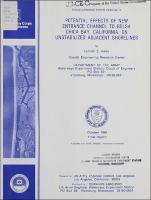Please use this identifier to cite or link to this item:
https://hdl.handle.net/11681/8429| Title: | Potential effects of new entrance channel to Bolsa Chica Bay, California, on unstabilized adjacent shorelines |
| Authors: | United States. Army. Corps of Engineers. Los Angeles District Hydraulics Laboratory (U.S.) Hales, Lyndell Z. |
| Keywords: | Bolsa Chica Bay (Calif.) Channels (Hydraulic engineering) Littoral drift--California--Simulation methods Shore-lines--California |
| Publisher: | Coastal Engineering Research Center (U.S.) Engineer Research and Development Center (U.S.) |
| Series/Report no.: | Miscellaneous paper (U.S. Army Engineer Waterways Experiment Station) ; CERC-84-10. |
| Abstract: | Abstract: Access to the open ocean from Huntington Harbor, California, is obtained by passage through Anaheim Bay which is heavily used by US Naval Weapons Station, Seal Beach. Concern has existed for many years about the possibility of accidental encounters between civilian and military craft in this area where ammunition off-loading and storage are routine practices. Local interests have requested US Army Engineer District, Los Angeles, to investigate the practicality of the construction of a new navigation entrance channel connecting Bolsa Chica Bay with the Pacific Ocean. Functional requirements of such a new entrance channel will necessitate stabilization by the use of a parallel or arrowhead jetty system. Otherwise, the large net downcoast drift of littoral material will rapidly close the entrance channel and prelude navigation. At the same time, any jetty system will interrupt the transport of littoral material in the surf zone and deplete the downcoast (in terms of net transport) beaches of their nourishment from upcoast sources. Consequently, a sand bypassing concept must be developed to operate in concert with a weir jetty system. The jetty system is necessary for navigational channel stabilization and a sand bypassing system is required to mitigate effects of the jetties on the recreational beaches of Bolsa Chica Beach State Park. The purposes of this study were to: (a) estimate the nearshore wave climate in the vicinity of potential new navigation entrance channel construction for structure design wave determination, and (b) to adapt computer simulation modeling of longshore transport of littoral material to estimate the resulting unstabilized shoreline evolution from jetty construction and example representative material bypassing at Bolsa Chica Beach State Park, California. The wave heights and their frequency of occurrence were determined at five locations along the potential new structure site (10-, 15- , 20- , 25-, and 30-ft water depths). The maximum wave height at the structure for all waves is less than the breaking wave height for water depths of 30, 25, and 20 ft, and the proposed structure will be subjected to nonbreaking waves in these water depths. In shallower water, however, the combined effect of refraction and shoaling increases and the waves may break. These portions of the structure will be subjected to breaking waves of various periods from certain directions of approach. These data are presented in tabular form. In order to estimate the effects of a weir jetty system and sand bypassing techniques on the adjacent unstabilized shorelines, it is necessary to have an understanding of the potential longshore transport of littoral material in the surf zone. The refraction analysis and wave hindcast data used for estimating the structure design wave were extended to calculate the potential longshore transport for the region of coastline extending from Surfside- Sunset Beach to Huntington Harbor. It was determined that on the average, approximately 376,600 cu yd of material moves toward the southeast each year, and about 100,700 cu yd of material is transported northwesterly each year, resulting in a net southerly transport of about 275,900 cu yd/yr. A computer simulation model for shoreline evolution was adapted to this region and calibrated for known movement of material from the feeder beach located at Surfside-Sunset Beach. Because the renourishment interval for the feeder beach is expected to be about 5 years, the numerical model was operated for this period of time (with a time increment for computational purposes of 1 hr). The two critical times of the year in this region are toward the end of May (following a large volume of southerly transport movement) and toward the end of December (at the end of the northerly transport season). At these times, the shoreline will have advanced or retreated to its farthest position during the year’s oscillations. The length of the sandtight landward section of the proposed navigation entrance channel west jetty between the preconstruction existing shoreline and the weir determines the extent of fillet formation that will evolve and ultimately the volume of material that will be available for transport back upcoast toward the erosional beach area. Results of this study into the potential effects of a new entrance channel (and the necessary stabilizing structural measures) to Bolsa Chica Bay, California, on the unstabilized adjacent shorelines are detailed in tabular and graphical form. |
| Description: | Miscellaneous paper |
| Rights: | Approved for public release; distribution is unlimited. |
| URI: | http://hdl.handle.net/11681/8429 |
| Appears in Collections: | Miscellaneous Paper |
Files in This Item:
| File | Description | Size | Format | |
|---|---|---|---|---|
| MP-CERC-84-10.pdf | 28.05 MB | Adobe PDF |  View/Open |